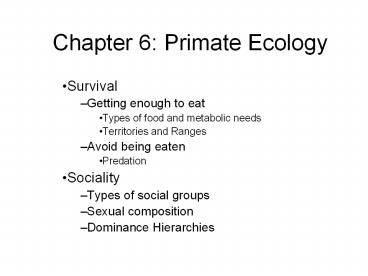Survival - PowerPoint PPT Presentation
1 / 15
Title:
Survival
Description:
Different primates eat different ... Polygyny one-male: Gorillas. Polygyny multimale: Chimps ... Bonobos don't compete with gorillas for food. More food to eat ... – PowerPoint PPT presentation
Number of Views:43
Avg rating:3.0/5.0
Title: Survival
1
Chapter 6 Primate Ecology
- Survival
- Getting enough to eat
- Types of food and metabolic needs
- Territories and Ranges
- Avoid being eaten
- Predation
- Sociality
- Types of social groups
- Sexual composition
- Dominance Hierarchies
2
Getting Enough to Eat
- Larger animals need more food overall
- Smaller animals need proportionally more calories.
3
Nutrients and Toxins
- Primates have diverse diets
- Different primates eat different combinations of
foods - Need a good source of protein and a good source
of carbohydrates (sugars)
4
Body Size and Diet are Related
5
Different Diets have Different Adaptive Problems
6
Eating, Traveling Resting
7
Territories vs. Ranges
Territories are not overlapping, boundaries are
defended
Ranges are overlapping, not exclusive
8
Predation
- Smaller primate more likely to be victims of
predators - Higher predation may lead to larger primates and
a shift in food - Effects choice of where you live
- Different defense mechanisms
- Shelters
- Activity patterns
- Warning calls
- Form of cooperation
- Multi species cooperation
- Different calls for different predators
9
Sociality
- Why be social?
- Two reasons (Alexander)
- To avoid predation
- Safety in numbers (tend to form large groups)
- Harder to feed everyone
- Common resources capture
- Social hunters (tend to be small)
- Diminishing return problem
- Collective defense of territory or competition
with other groups - Balance of power
10
Types of Primate Social Groups
Solitary Orangutans
Polygyny one-male Gorillas
Monogamous Gibbons
Polygyny multimale Chimps
Polyandrous Tamarinds
11
Resource Competition and Dispersal Patterns
- Resources are patchy and limited
- Greater competition and dominance hierarchies
- Within group competition greater than between
group - Females will form kin based coalitions
- Females will form dominance hierarchies
- Female philopatry Matrilocal
- Between group competition gt within group
competition - Females will be more egalitarian
- Females will still favor kin and be philopatric
12
- Both within and between group competition is
strong - Combination of the previous two contexts
- Females favor kin groups philopatric
- Females more egalitarian
- When resources are dispersed you get scramble
competition - Females have little motivation to form dominance
hierarchies - Females have little reason to form coalitions or
be philopatric - Rare?
- Where are the males?
- Males go where the unrelated females are.
- If females are philopatric then males must leave
their natal group to avoid inbreeding depression. - The more females in a group the more they become
a defendable (patchy) reproductive resource for
males - The more females in a group the harder for one
male to monopolize them, especially if they have
asynchronous estrus.
13
How do Chimps and Humans Fit in all of this?
- Not very well!
- Male philopatry Patrilocal (even Bonobos)
- The socioecological models presented in you book
would lead you to believe that Chimps and our
common ancestor live in a scramble competition
context, but they dont, and they are
territorial. - Other possibilities?
- Wrangham and Madson argue that
- Chimps and Human males will be territorial if
resources are defendable (patchy) and important
to females - If resources are not defendable, males will fight
over females
14
Cost of Grouping Hypothesis (Wrangham)
- Males have an advantage in the cost of grouping
- Males can forage farther for the same energy
costs (more efficient) because they are caring
babies or the extra weight of pregnancy (women
paying a higher cost for reproduction) - You can put more males in a given area (fixed
amount of food) than you can put females - Because of the lower cost of grouping men form
larger groups than males. - They use there larger coalitions to compete with
other groups of males, but also to dominate
females.
15
What about Bonobos?
- Bonobos dont compete with gorillas for food
- More food to eat
- The cost of grouping goes down for males and
females - Females are not longer disadvantaged in terms of
the cost of grouping - Females are better at forming coalitions (through
sex) despite male philopatry (Patrilocallity) - Females dominate Males































